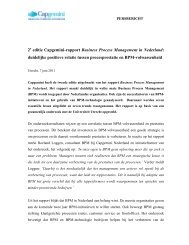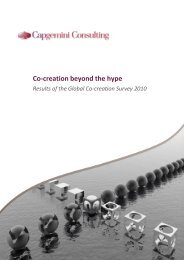IT transformations - Capgemini Consulting Nederland
IT transformations - Capgemini Consulting Nederland
IT transformations - Capgemini Consulting Nederland
You also want an ePaper? Increase the reach of your titles
YUMPU automatically turns print PDFs into web optimized ePapers that Google loves.
Paid content may be subscription<br />
or transaction based while<br />
advertisements help fund the long tail<br />
of non-paying consumers.<br />
These dual revenue streams<br />
improve the economic feasibility<br />
for the publisher. Spotify provides<br />
ad-supported music for free and the<br />
higher quality, advertisement-free<br />
music, with mobile phone access,<br />
for premium customers. Similarly,<br />
Hulu has a paid subscription with<br />
expanded content portfolio over free<br />
access though both versions have<br />
advertisements.<br />
The mobile gaming space has several<br />
games available for free with a<br />
restricted set of levels and features.<br />
Unlocking these requires payments. A<br />
recent mobile game, Angry Birds, has<br />
achieved 10 million purchases on the<br />
Apple App Store despite having free<br />
versions available 34 .<br />
Collection Societies<br />
The role of collection societies 35<br />
varies by country, market, service,<br />
and channel. There is significant<br />
fragmentation across these<br />
dimensions along with limited<br />
transparency. In some countries<br />
efforts are being made to expand<br />
the scope of collection societies into<br />
digital services such as radio, music<br />
and video streaming. For example<br />
Buma Stemra in the Netherlands has<br />
introduced a collection mechanism<br />
for online downloads and streams<br />
comprising of flat rates and variable<br />
models where 8-12% of revenue is<br />
shared 36 .<br />
Recommendations<br />
Future roadmaps for content owners<br />
need to move beyond just packaging<br />
traditional content in digital formats.<br />
This includes looking at curbing<br />
piracy, creating new revenue<br />
models and providing superior<br />
content consumption ecosystems<br />
(see Figure 5).<br />
Deter Piracy through Legislation<br />
In the long run a credible deterrent<br />
for the average pirating consumer<br />
is a necessity. Directly prosecuting<br />
consumers and platforms has seen<br />
limited success. An effective option,<br />
also validated by the content industry<br />
in our research 37 , is to block Internet<br />
access of pirating consumers. This<br />
requires legislation along the lines of<br />
the “three strikes” model. Industry<br />
associations will need to lobby<br />
for laws such as HADOPI in their<br />
respective countries.<br />
Figure 5: Key Recommendations for Ensuring Superior Monetization of Digital IP<br />
Traditional<br />
Downloadable<br />
Content<br />
Enhanced<br />
Consumption<br />
Ecosystems<br />
Control Piracy<br />
Push for legislation to<br />
block internet access<br />
of pirating consumers<br />
Digital Content Monetization<br />
Increase Revenues<br />
Use both consumer payments<br />
and advertisement which is<br />
measured across all platforms<br />
Ecosystems that provide convenience and excellence in customer<br />
experience are difficult to duplicate and adds value to the content<br />
There are, however, challenges in<br />
pursuing this course. For one, it puts<br />
the implementation onus on ISPs.<br />
They are expected to act against their<br />
paying customers for the benefit of<br />
the content industry with which<br />
ISPs have no revenue sharing. Costs<br />
incurred by ISPs for such operations,<br />
thus, should be covered. Moreover,<br />
care should be taken to not alienate<br />
the consumers. Providing benefit<br />
of doubt to borderline cases could<br />
be helpful. Also, content owners<br />
should strive to maintain a degree of<br />
anonymity by ensuring that action is<br />
taken by an independent body and<br />
not a specific content owner.<br />
Employ Multiple Monetization<br />
Models<br />
Generating profitable advertisement<br />
revenue is a challenging task. For<br />
instance, Blinkbox, an on-demand<br />
video streaming service, estimates<br />
that breaking even requires over<br />
60 million monthly streams, a<br />
reach that only Google and the<br />
BBC can command in the UK<br />
market 38 . At the same time, a low<br />
consumer propensity to pay means<br />
that sufficient consumer payments<br />
are not likely to be widespread<br />
either. Most providers would need a<br />
combination of advertisements and<br />
paying customers. Companies that<br />
cater to niche user groups and/or offer<br />
specialized content should, however,<br />
construct their model around<br />
consumer payments.<br />
In all the cases, content owners<br />
need to hit the sweet spot of pricing<br />
by matching it with the perceived<br />
value of content and convenience in<br />
that particular format. Advertising<br />
revenue would improve by delivering<br />
advertisements tailored to a device’s<br />
capabilities while measuring<br />
audiences across all platforms.<br />
Source: <strong>Capgemini</strong> TME Strategy Lab Analysis<br />
34 Yahoo! News, (Not so) Angry Birds passes 10 million iPhone downloads, November 2010.<br />
35 Collection societies are responsible for collecting royalty by licensing content on behalf of the copyright holder.<br />
36 Buma Stemra, Digitale tarieven: On Demand, December 2010.<br />
37 <strong>Capgemini</strong> Primary Research, 2010.<br />
38 Broadband TV News, On demand Blinkbox on a roll, November 2010<br />
72
















